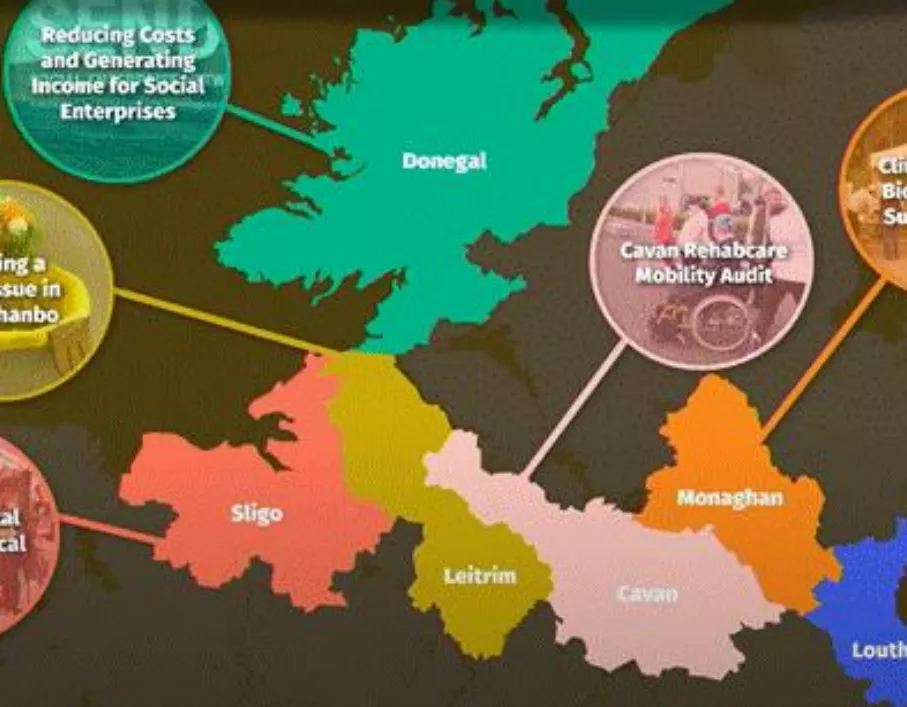Summary
The ‘Innovating Communities’ project promoted community-led initiatives across six participating Local Action Group (LAG) areas spanning Donegal, Leitrim, Sligo, Cavan, Monaghan and Louth. This was achieved by imparting ‘design thinking’, a creative problem-solving methodology, to community groups, businesses and individuals through a series of facilitated courses tailored to address local challenges.
The project successfully trained 1 470 people, addressing 227 local opportunities and 51 challenges proposed by community groups and individuals. It also trained 38 local people to become co-trainers, ensuring the continuity of problem-solving expertise within the region beyond the project's end.
Results
The project boasts remarkable results that underscore its profound impact. A total of 1 470 individuals were successfully trained in problem-solving tools, thanks to which communities across the region identified 227 opportunities and addressed 51 challenges. The project saw high satisfaction rates among participants, exceeding 90%, while over 70% of participants expressed that the course had empowered them with fresh ideas to benefit their communities.
Significantly, the project extended its reach to engage new cohorts, including young people and migrants. To ensure the initiative’s sustainability, 38 local co-trainers were instrumental in embedding the legacy of the project in their respective communities, and a remarkable 878 young people were equipped with valuable problem-solving skills.
The project made its mark by hosting a LEADER showcase event to disseminate its learning and achievements and bring insights to both national and international platforms, further amplifying its impact.
Resources
Documents
Context
Situated in Ireland's Southern Border Region, this area predominantly comprises rural landscapes. This region grapples with a range of significant challenges, including concerns related to the repercussions of Brexit on local Border communities. There is also a prevailing issue of social and economic marginalisation. What truly stands out as a requirement in this context is the necessity for empowering these communities with the capability to engage in grassroots problem solving. The Southern Border counties often find themselves geographically distant from the arenas of policy formation and centres of influence. As a result, they need to develop the agility to swiftly and effectively address various emerging challenges, such as climate transition, healthcare services, mobility, food supply chains and the impact of shifting weather patterns.
The answer to these multifaceted challenges lies in providing these communities with appropriate training and tools, thereby equipping them to become more adept problem solvers and self-reliant innovators.
Objectives
This project was created to enable communities to respond more efficiently to local challenges and enhance their creative problem-solving capacities through design thinking. It aimed to address the region's primary challenges and foster community involvement in crafting responses and generating new ideas. Ultimately, it sought to expand local ownership of strategies, plans and opportunities.
Activities,key actors, and timeline
To get inspiration from other successful cases, the partners embarked on an enlightening trip to Steyr, Austria, to explore innovative approaches through a visit to a LEADER Cooperation pilot known as Nature of Innovation. Following this, the project delved into the development of a comprehensive community training and capacity-building programme centred around the principles of design thinking. To bring this programme to life, a training provider was contracted to facilitate design thinking workshops throughout the region. For a well-structured project, clear key performance indicators were set. These objectives aimed to deliver over 100 training courses across the region, encompassing LEADER staff, trainers, co-trainers and local community members who contributed challenge topics for training. In line with these objectives, the plan was to train 924 individuals, making use of a total of 6,048 training hours. Additionally, the project sought to cultivate a group of 24 local co-trainers who would serve as an ongoing resource for the community. Over a span of two and a half years, the project diligently provided training sessions on design thinking tools and person-centred design across the region. Regular meetings were held with partners, the training provider and the project evaluator to ensure everything was proceeding smoothly. To amplify the impact of this initiative, local co-trainers were recruited as dedicated volunteers to assist in training sessions. Finally, an Innovating Communities showcase event was hosted to share the learning and outcomes with a broader audience, includinga live stream for wider accessibility
Success factors/lessons learnt
The initiative effectively used design thinking to identify and address community challenges. The methodology’s systematic, five-stage process, beginning with an ‘empathy’ analysis of those affected by the project and culminating in final, tangible solutions, served as a cornerstone for the project's success. The approach's versatility and efficacy are notable, making it applicable to other territories and scalable to tackle complex rural challenges, such as climate change and migration, promoting flexible and innovative strategies. Regarding sustainability, the Innovating Communities approach aligns seamlessly with the LEADER/CLLD (community-led local development) methodology. Its success, however, relies on substantial investment in local rural community facilitation. This co-design approach holds significant potential for mainstream adoption, enhancing policy decisions and local development through its demonstrated impact. Key lessons include the seamless integration of design thinking with the LEADER developmental approach, promoting democratic, bottom-up engagement, amplifying community involvement and fostering creativity in problem solving. The Innovating Communities process reflects a commitment to animate and facilitate rural populations, effectively addressing pressing issues while encouraging wider community engagement in the co-design process. The most valuable lesson learned from this initiative is that when local communities are empowered to seek solutions, they enthusiastically embrace their role in addressing rural challenges.
Contacts
Gabriel O’Connell, CEO Monaghan Integrated Development CLG, goconnell@midl.ie

